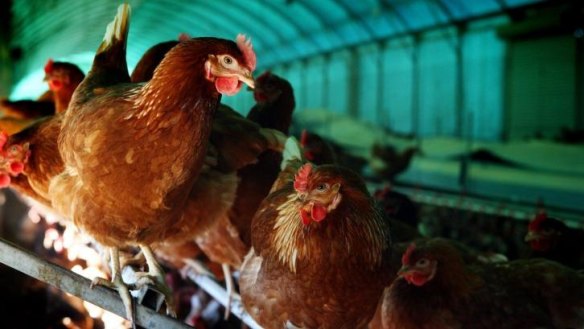Laying out the facts on free-range egg prices

Paying a little more may get you free-range eggs laid by hens that can bask in the sunlight, but price is no guarantee of that.
Consumer advocacy group Choice's study found free-range eggs from farms with 1500 hens per hectare on average cost $1.12 per 100 grams. But there were ones from farms with 10,000 hens per hectare charging more, such as Ecoeggs.
"It's a farce. We looked at 55 free-range egg products from 93 supermarkets across Australia and there's no absolute correlation between price and stock density," said Choice's director of campaigns Matt Levey.
"Egg producers are profiting from the free-range labelling confusion. It's a big loophole that some producers have exploited for far too long."
The study, to be released on Wednesday, will ramp up pressure on Australia's consumer affairs ministers, who will meet in Melbourne on Friday, to end the confusion.
Choice is demanding an enforceable national standard that would replace the patchwork of voluntary codes and laws – free-range stock density rules span 750 to 10,000 hens per hectare – across the country.
Federal Small Business Minister Bruce Billson, who will chair the forum, said they will discuss five possible solutions: the status quo, an industry-developed trademark scheme, a revised model code, an industry code of conduct and a national information standard.
"The range reflects the number of moving parts in this discussion. One is so consumers can be confident about what terms actually mean and therefore make an informed decision," he said.
"Also, egg producers want to know what they need to do to claim a premium standing or higher value product so they're not troubled by false or misleading claims allegations."
Billson said all five options had "enforcement capability attached to them". He plucked the status quo as an example, highlighting the string of federal court action taken against dodgy egg producers by the Australian Competition and Consumer Commission.
At Friday's meeting, NSW Minister for Innovation and Better Regulation Victor Dominello will be advocating for the National Information Standard, which will ultimately include a legal definition for "free-range".
Despite ballooning free-range egg sales and, in tandem, consumer confusion, he conceded it may take years for the public to witness decisive action.
"I don't know if we'll get to a once and for all, definitive position on Friday because it will be a two or three stage process. If we can at least agree to a national standard, then we can start working on the definitions," he said.
"All sectors are crying out for this, the consumers and producers crying out for clarity."
Choice acknowledges that the term "free-range" should be based on factors beyond stock densities, such as size and location of openings and outdoor and indoor conditions.
But as well as a mandatory national standard, it is demanding a logo be applied to every product clearly indicating stock density levels.
John Coward, chief executive of Queensland United Egg Producers and spokesperson of Egg Farmers of Australia, said it was ignorant of Choice to place so much focus on stock density and rejected the logo proposal.
"It will be misleading as there are too many variables and other impacts that come into it. Stock density should not be the key focus," he said.
"The focus should be on the management practices at each level of densities, factors such as the range area, the provision of shelter, the outdoor environment, access to range, and so on."
The Australian Egg Corporation has previously proposed "free-range" stock density levels at 20,000 hens per hectare. This was later rejected by the ACCC, which deemed it as misleading.
Choice, which launched a fresh campaign for meaningful labelling, said the study also showed shoppers were paying on average 55 cents per 100 grams for caged eggs, 71 cents for barn laid eggs, and 99 cents for free-range.
Of the 55 free-range egg products, only 24 provided stock density details on the packaging or online. For 11 of the products, Choice had to request the information.
The producers of 20 free-range egg products refused to reveal stock density levels, including IGA Signature, Pirovic and Field Fresh.
Only 2 per cent of free-range egg buyers believe that farms running at 10,000 hens per hectare is acceptable, according to a recent Choice survey.
But Pace Farm, Farm Pride and Manning Valley account for a third of the free-range market and each operate at 10,000 hens per hectare.
Given the grocery volume of free-range eggs sold last year was 696 million, according to Retail World, Choice estimates at least 213 million eggs bought by Australians did not meet their expectations of free-range.
Restaurant reviews, news and the hottest openings served to your inbox.
Sign up- More:
- Restaurant news
